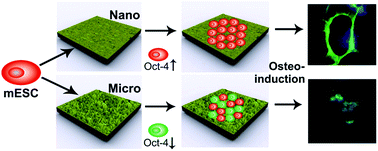a The Key Lab of Health Chemistry and Molecular Diagnosis of Suzhou, Department of Polymer Science and Engineering, College of Chemistry, Chemical Engineering and Materials Science, Soochow University, Suzhou 215123, P. R. China
Nanoscale 2014, 6, 6959-6969
Efficient control of the self-renewal and pluripotency maintenance of embryonic stem cell (ESC) is a prerequisite for translating stem cell technologies to clinical applications. Surface topography is one of the most important factors that regulates cell behaviors. In the present study, micro/nano topographical structures composed of a gold nanoparticle layer (GNPL) with nano-, sub-micro-, and microscale surface roughnesses were used to study the roles of these structures in regulating the behaviors of mouse ESCs (mESCs) under feeder-free conditions. The distinctive results from Oct-4 immunofluorescence staining and quantitative real-time polymerase chain reaction (qPCR) demonstrate that nanoscale and low sub-microscale surface roughnesses (Rq less than 392 nm) are conducive to the long-term maintenance of mESC pluripotency, while high sub-microscale and microscale surface roughnesses (Rq greater than 573 nm) result in a significant loss of mESC pluripotency and a faster undirectional differentiation, particularly in long-term culture. Moreover, the likely signalling cascades engaged in the topological sensing of mESCs were investigated and their role in affecting the maintenance of the long-term cell pluripotency was discussed by analyzing the expression of proteins related to E-cadherin mediated cell–cell adhesions and integrin-mediated focal adhesions (FAs). Additionally, the conclusions from MTT, cell morphology staining and alkaline phosphatase (ALP) activity assays show that the surface roughness can provide a potent regulatory signal for various mESC behaviors, including cell attachment, proliferation and osteoinduction.

链接:
//pubs.rsc.org/en/content/articlelanding/2014/nr/c4nr01540a#!divAbstract